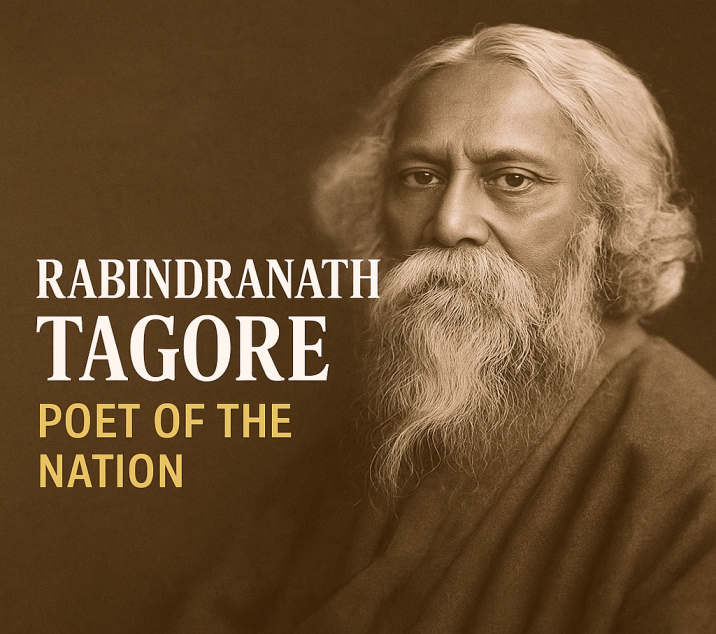Rabindranath Tagore Biography – Life, Works, Education & Contributions, Full details updated 2025.
Rabindranath Tagore Biography
Discover the life story of Rabindranath Tagore Biography – poet, philosopher, Nobel laureate, and cultural icon of India. Know about his early life, major works, achievements, and contributions to literature and education.
Table of Contents
Early Life and Education
Rabindranath Tagore was born on May 7, 1861, in Jorasanko, Kolkata, India, into a wealthy and culturally rich Bengali Brahmin family. He was the youngest son of Debendranath Tagore, a philosopher and religious reformer associated with the Brahmo Samaj.
Tagore did not follow conventional schooling. He was largely home-tutored and exposed to a wide range of subjects like literature, music, philosophy, and art. In 1878, he briefly attended school in England, studying law at University College London, but returned to India without completing his degree.
Despite not receiving a formal degree, his exposure to Western education and philosophy influenced his thought process deeply. His early interest in literature was nurtured by his father and the intellectual environment at home.
Literary Career and Major Works
At just 16, Tagore published his first book of poems, Kabi Kahini, using the pen name ‘Bhanusimha’. Over his lifetime, he authored over 2,000 songs, 30 volumes of poetry, 8 novels, numerous short stories, plays, and essays.
His most famous work, Gitanjali (Song Offerings), won him the Nobel Prize in Literature in 1913, making him the first Asian to receive this prestigious award. The poems reflect a deep spiritual devotion and a universal humanistic vision.
Other notable works include:
- Gora (Novel)
- The Home and the World (Ghare-Baire)
- Chokher Bali
- Shesher Kabita
- Kabuliwala (Short story)
Contributions to Music and Art
Tagore wasn’t just a great writer, he was also a talented musician and painter. He created Rabindra Sangeet, a special kind of music that mixes Indian classical tunes with poetic lyrics. His compositions are revered across Bengal and India.
He also wrote the national anthems of India (Jana Gana Mana) and Bangladesh (Amar Shonar Bangla). His music continues to inspire generations and forms an integral part of Indian cultural identity.
Role in Education and Founding of Santiniketan
In 1901, Tagore founded a school at Santiniketan (later known as Visva-Bharati University), based on the gurukul system, blending Eastern and Western educational ideals. He believed that education should foster creativity, spiritual growth, and a love for nature—not just academic success.
His model was unique in its emphasis on freedom of learning, internationalism, and respect for cultural diversity. Santiniketan became a hub of art, philosophy, and cultural exchange.
5 important life lessons from the life of Rabindranath Tagore:
1. Value Inner Freedom Over External Success
Tagore believed in personal freedom and spiritual growth. He chose truth, self-expression, and creativity over conventional achievements, teaching us to listen to our inner voice and not be confined by societal expectations.
2. Education Must Nourish the Soul
Through Santiniketan, Tagore showed that education should inspire curiosity, creativity, and a love for nature, not just rote learning. He taught that learning should be joyful and liberating, not stressful.
3. Art and Literature Are Tools of Unity
Tagore used poetry, music, and stories to bridge cultural and national boundaries. He believed art can connect humanity, making us more compassionate and understanding.
4. Stand Up for Justice Peacefully
Tagore protested injustice without violence. He returned his knighthood after the Jallianwala Bagh massacre, showing that one can resist oppression with dignity and principle.
5. Keep Evolving Throughout Life
Tagore wore many hats, he was a poet, musician, painter, thinker, and teacher, all in one. He constantly reinvented himself, proving that we should never stop learning, exploring, or growing—no matter our age.

Political Thoughts and Philosophy
Tagore wasn’t active in politics, but he boldly spoke out against British rule. In 1919, he gave up his knighthood to protest the Jallianwala Bagh Massacre. However, he always promoted non-violence, unity, and peace.
He had a nuanced relationship with Mahatma Gandhi—mutually respectful but ideologically different. While Gandhi was a nationalist, Tagore considered himself an internationalist, emphasizing the unity of mankind.
Death and Legacy
Rabindranath Tagore breathed his last on August 7, 1941, in Kolkata, leaving behind a timeless legacy of art, literature, and wisdom. His legacy lives on in the form of his literature, music, educational ideas, and cultural reforms. His contributions are recognized globally, and his thoughts continue to influence literature, education, and humanism.
Final Thoughts
Rabindranath Tagore was a true polymath, a poet, novelist, painter, philosopher, educator, and reformer. His creative genius and spiritual insight transcended national boundaries, making him one of the greatest literary figures the world has ever seen. His life and work continue to inspire millions in India and beyond.
